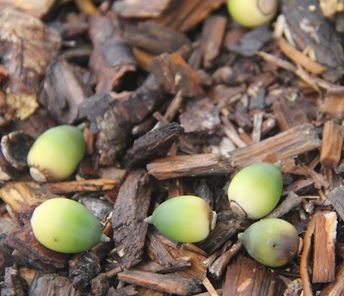



Shorter Grass Opens Up Cows to Green Acorn Poisoning
What is food for squirrels is deadly to cattle, explain Georgia advisers after insect activity has exposed green acorns in many Georgia pastures.Too many acorns lead to “Quercus”— acorn poisoning in cattle, Georgia graziers are being warned.
The word “quercus” comes from the scientific, or botanical, name for oak, writes Frank M. Watson of Georgia University extension.
Quercus poisoning occurs when cattle consume too many oak buds or acorns. Most animals are susceptible, but cattle and sheep are most often affected by this malady.
Armyworms Didn't Leave Much

In pastures where grass is short, cattle producers should be acutely aware of the potential for Quercus poisoning. Mr Watson writes that, even though Georgia has received ample rain recently, armyworms mowed down the grass in many pastures. When the forage supply is limited, as is the case with grass due to the armyworms, cows may be tempted to eat green acorns.
A little forethought could prevent a tragedy later. When cows consume large quantities of young oak leaves in the spring or green acorns in the fall, clinical signs appear several days later.
These signs include lack of appetite, depression, emaciation, serious nasal discharge and constipation followed by diarrhea, ranging from mucoid to hemorrhagic. The toxins can cause kidney damage that could lead to serious future health problems. Kidney damage caused by Quercus poisoning is irreversible.
Since kidney damage is not easily noticeable, cattlemen should take preventative measures, including fencing cattle out of areas where they have been observed eating acorns. In fact, cost of fencing or lack of other grazing areas may force producers to risk exposure to Quercus poisoning.
Take Preventative Measures
Calcium hydroxide comprising 10 percent of the ration may be used as a preventive measure if exposure to acorns cannot be avoided. This may be a feasible alternative for dairymen who have cattle on a controlled diet, but is impossible for beef cattle producers who have no control over their animals’ diets in a pasture situation.
Calves and yearlings seem to be affected more often than mature cattle, as the effect is most likely a function of body size. An adult cow would have to consume more acorns or leaves than a younger, smaller animal to receive the same level of toxicity.
Producers should make sure forage is available. If there is not adequate grazing, provide hay. Cattle who don’t have adequate forage or hay will be tempted to eat the acorns, especially after the frost kills the grass.
Don't Eat the Green Ones!
Green acorns and leaves are the most toxic. As acorns cure after falling, they will become less toxic as a function of time, requiring animals to eat more to get the same level of toxicity. Cured acorns should also be less desirable to animals than green ones.
This problem will diminish with time, but it’s not going to go away overnight. Depending on which other foods are available, it could take as long as two months for the danger to pass.


